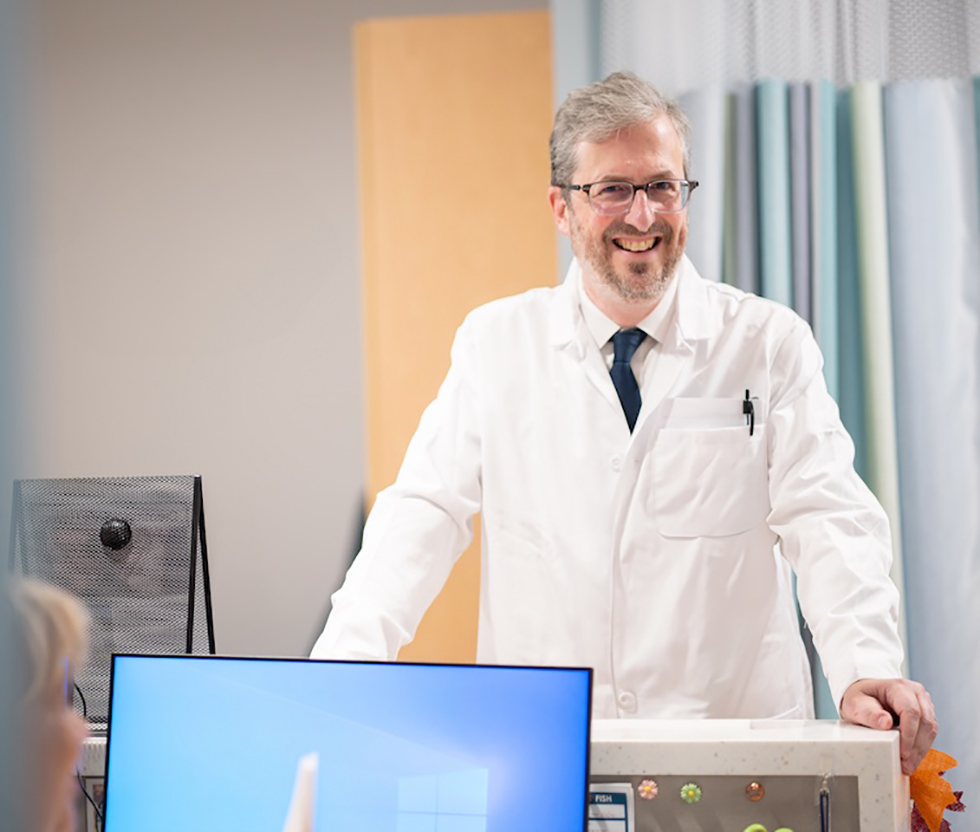
Alzheimer’s and related dementias also cause motor symptoms, like hand tremors or weakness. And there can be neuropsychiatric symptoms: angry outbursts, sudden apathy, even visual hallucinations. Loss of appetite and weight loss and trouble getting to sleep or staying asleep are also common signs of Alzheimer’s and other common forms of dementia, which afflict more than 6 million people in the United States – including 40% of people over the age of 85, according to federal statistics.
“Alzheimer’s and other dementias are not just diseases that affect memory,” said Huey, the associate director for Brown’s Center for Alzheimer’s Disease Research.“There are a host of other symptoms, and we don’t have the luxury of ignoring them.”
Huey is the Martin M. Zucker Professor of Psychiatry and Human Behavior in Brown’s Division of Biology and Medicine and sees dementia patients at Butler Hospital, where he leads the Memory and Aging Program.
Huey has committed his career as a physician and scientist to understanding the surprisingly huge swath of signs and symptoms of Alzheimer’s disease and related dementias. This process is called phenotyping, an art and science that is critical for proper diagnosis and treatment. If doctors miss the signs, they miss the diagnosis. Or they can make the wrong diagnosis and prescribe the wrong drugs. Either way, patients and their caregivers suffer.
In his talk at the 2024 National Institutes of Health Alzheimer’s Research Summit, Huey not only made the case that dementia affects mood and behavior in addition to thinking and movement, but that these neuropsychiatric symptoms can be found in most types of dementia.
In a stunning example, Huey explained how 12 neuropsychiatric symptoms – from agitation to anxiety, irritability to disinhibition – could be found in patients with every common form of dementia, including Alzheimer’s disease, vascular dementia, dementia with Lewy bodies, cerebral amyloid angiopathy, frontotemporal lobar degeneration, and hippocampal sclerosis.
“These neuropsychiatric symptoms are common, and they overlap between disorders,” he said. “What this means is that we need to broaden our view of Alzheimer’s and other dementias – not only in what we look for in the clinic but also what we study in the lab and what kinds of clinical trials we bring to patients.”
This fresh, multidimensional view of Alzheimer’s disease will inform the new Center for Alzheimer’s Disease Research, which integrates the expertise of the Carney Institute for Brain Science and Brown’s Division of Biology and Medicine.
Bess Frost, Ph.D., a pioneering scientist focused on the neurobiology of aging brains, is leading the center. Together with Huey, she is recruiting the center’s first new hire, raising money, and building research infrastructure, including a bank of brain tissue and other biological samples to support research. The center will be housed in the William A. and Ami Kuan Danoff Life Science Laboratories when the new lab opens in 2027.
At the summit, sponsored by the National Institute on Aging and held on the National Institutes of Health campus in Bethesda, Maryland, Huey said he spotted trends that will help Brown’s rapidly growing Alzheimer’s research program.
Huey said federal agencies are taking a broader view of dementias and expanding research resources beyond the study of amyloid, a key protein that causes dementia. For example, Huey heard an intriguing talk on environmental exposures like lead or air pollution and how they might contribute to Alzheimer’s. This developing area of research is sometimes called the “exposome” – all the experiences and exposures over the course of a lifetime that affect the risk of developing Alzheimer’s disease.
This more nuanced view of dementia, Huey said, is good news for the Center for Alzheimer’s Disease Research and its science portfolio. Along with his work in phenotyping, Frost is studying non-amyloid inflammation and the role it plays in the onset and progression of Alzheimer’s disease.
At the NIH, Huey also heard a lot of discussion about scientific data – especially the need to make it accessible and usable. Huey has an NIH grant to do just that, taking big clinical data sets from dementia trials and making it comparable and searchable.
“Availability of data was a big theme at the summit,” he said. “If you collect data that the NIH funds, they want that de-identified and up online quickly. The days of data hoarding are over.”
Huey said he left the summit energized.
“Dementias are diverse, and because of that, treatments need to be personalized,” he said. “People in the field are getting that. They’re keeping an open mind and embracing the complexities of these diseases.”